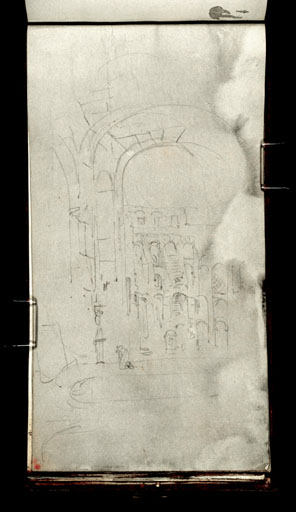Joseph Mallord William Turner Inside the Colosseum, Rome 1819
Image 1 of 2
Joseph Mallord William Turner,
Inside the Colosseum, Rome
1819
Joseph Mallord William Turner 1775–1851
Folio 14 Verso:
Inside the Colosseum, Rome 1819
D16414
Turner Bequest CXC 14 a
Turner Bequest CXC 14 a
Pencil and grey watercolour wash on white wove paper, 255 x 130 mm
Accepted by the nation as part of the Turner Bequest 1856
References
1909
A.J. Finberg, A Complete Inventory of the Drawings of the Turner Bequest, London 1909, vol.I, p.565, as ‘In the Colosseum.’.
2008
Nicola Moorby, ‘Un tesoro italiano: i taccuini di Turner’, in James Hamilton, Nicola Moorby, Christopher Baker and others, Turner e l’Italia, exhibition catalogue, Palazzo dei Diamanti, Ferrara 2008, pp.102, 105 note 31.
2009
Nicola Moorby, ‘An Italian Treasury: Turner’s sketchbooks’, in James Hamilton, Nicola Moorby, Christopher Baker and others, Turner & Italy, exhibition catalogue, National Galleries of Scotland, Edinburgh 2009, pp.115, 155 note 32.
Arguably the most famous of all the surviving monuments of classical Rome is the Flavian Amphitheatre, a huge building universally known as the Colosseum, which stands at the eastern end of the Roman Forum between the Palatine and Esquiline Hills. Built 72–80 AD., the immense ruin was as popular with tourists during the eighteenth and nineteenth centuries as it is today and its crumbling but impressive remains represented a constant source of inspiration for artists. Turner’s 1819 sketches demonstrate that he studied the Colosseum from a variety of viewpoints both inside and outside the celebrated structure.1 He had read John Chetwode Eustace’s book, A Classical Tour Through Italy, which stated that ‘Never did human art present to the eye a fabric so well calculated by its size and form, to surprise and delight’ (see the Italian Guide Book sketchbook, Tate D13943; Turner Bequest CLXXII 7).2 Eustace recommended viewing the building first from the north, and then the south before finally entering its ‘lofty arcades’ to consider the ‘vast mass of ruin ... insulated walls, immense stones suspended in the air, arches covered with weeds and shrubs, vaults opening upon other ruins ... in short, above, below, and around, one vast collection of magnificence and devastation, of grandeur and decay’.3
This sketch depicts a view of the interior seen through a ground floor arch. Like many drawings within this sketchbook, the composition has been executed over a washed grey background. Turner has used the page vertically in portrait format in order to capture a sense of the full height of the arena and its successive storeys of arcades. A further sense of scale is introduced by the small robed figure kneeling in prayer in the foreground and one of the altars to the fourteen Stations of the Cross visible in the centre. In 1750, Pope Benedict XIV had consecrated the building to the memory of the early Christians who were martyred there and the ruins became a site for Catholic worship.
Nicola Moorby
May 2009
How to cite
Nicola Moorby, ‘Inside the Colosseum, Rome 1819 by Joseph Mallord William Turner’, catalogue entry, May 2009, in David Blayney Brown (ed.), J.M.W. Turner: Sketchbooks, Drawings and Watercolours, Tate Research Publication, December 2012, https://www


